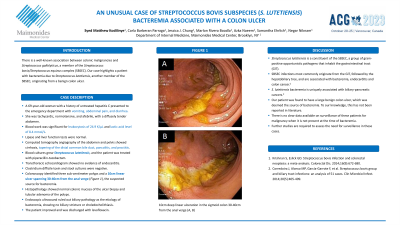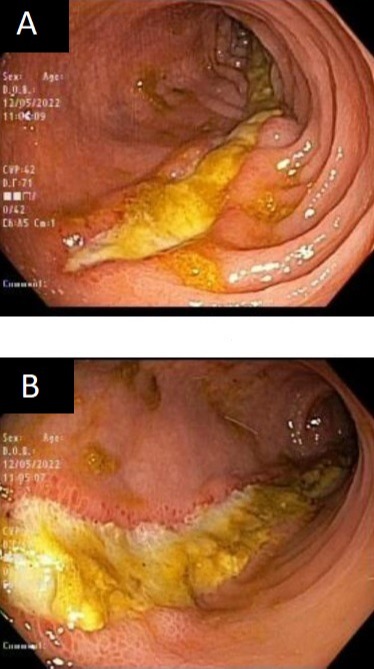Sunday Poster Session
Category: Colon
P0232 - An Unusual Case of Streptococcus bovis Subspecies (S. lutetiensis) Bacteremia Associated With a Colon Ulcer
Sunday, October 22, 2023
3:30 PM - 7:00 PM PT
Location: Exhibit Hall

Has Audio

Syed M. Kodilinye, MBBS
Maimonides Medical Center
New York, NY
Presenting Author(s)
Syed M. Kodilinye, MBBS1, Carla Barberan Parraga, MD2, Jessica J. Chung, MD, MPH2, Marlon Rivera, MD2, Azka Naeem, MBBS2, Samantha S. Ehrlich, MD, MPH2, Negar Niknam, MD2
1Maimonides Medical Center, New York, NY; 2Maimonides Medical Center, Brooklyn, NY
Introduction: There is a well-known association between colonic malignancies and Streptococcus gallolyticus, a member of the Streptococcus bovis/Streptococcus equinus complex (SBSEC). Our case highlights a patient with bacteremia due to Streptococcus lutetiensis, another member of the SBSEC, originating from a benign colon ulcer.
Case Description/Methods: A 69-year-old woman with a history of untreated hepatitis C presented to the hospital with vomiting, abdominal pain, and diarrhea. She was tachycardic, normotensive, and afebrile, with a diffusely tender abdomen. Initial blood work was significant for WBC of 24.9 K/µL and lactic acid of 8.4 mmol/L. Lipase and liver function tests were normal. Computed tomography angiography of the abdomen and pelvis showed cirrhosis, tapering of the distal common bile duct, pancolitis and proctitis. Blood cultures grew Streptococcus lutetiensis, and the patient was treated with piperacillin-tazobactam. Transthoracic echocardiogram showed no evidence of endocarditis. Clostridium difficile toxin and stool cultures were negative. Colonoscopy identified three sub-centimeter polyps and a 10cm linear ulcer spanning 30-40cm from the anal verge, the suspected source of bacteremia. Histopathology showed normal colonic mucosa of the ulcer biopsy and tubular adenoma of the polyps. Endoscopic ultrasound ruled out biliary pathology as the etiology of bacteremia, showing no biliary stricture or choledocholithiasis. The patient improved and was discharged with levofloxacin.
Discussion: Streptococcus lutetiensis is a constituent of the SBSEC, a group of gram-positive opportunistic pathogens that inhabit the gastrointestinal tract (GIT). SBSEC infections originate from the GIT and hepatobiliary tree and are associated with bacteremia, endocarditis and colon cancer.1 S. lutetiensis bacteremia is uniquely associated with biliary-pancreatic cancers.2 Our patient was found to have a large benign colon ulcer, which was deemed the source of bacteremia. To our knowledge, this has not been reported in literature. There is no clear data on surveillance of these patients for malignancy when it is not present at the time of bacteremia. Further studies are required to assess the need for surveillance in these cases.
1. Krishnan S, Eslick GD. S. bovis infection and colorectal neoplasia: a meta-analysis. Colorectal Dis. 2014;16(9):672-680.
2. Corredoira J, Alonso MP, García-Garrote F, et al. S. bovis group and biliary tract infections: an analysis of 51 cases. Clin Microbiol Infect. 2014;20(5):405-409.

Disclosures:
Syed M. Kodilinye, MBBS1, Carla Barberan Parraga, MD2, Jessica J. Chung, MD, MPH2, Marlon Rivera, MD2, Azka Naeem, MBBS2, Samantha S. Ehrlich, MD, MPH2, Negar Niknam, MD2. P0232 - An Unusual Case of Streptococcus bovis Subspecies (S. lutetiensis) Bacteremia Associated With a Colon Ulcer, ACG 2023 Annual Scientific Meeting Abstracts. Vancouver, BC, Canada: American College of Gastroenterology.
1Maimonides Medical Center, New York, NY; 2Maimonides Medical Center, Brooklyn, NY
Introduction: There is a well-known association between colonic malignancies and Streptococcus gallolyticus, a member of the Streptococcus bovis/Streptococcus equinus complex (SBSEC). Our case highlights a patient with bacteremia due to Streptococcus lutetiensis, another member of the SBSEC, originating from a benign colon ulcer.
Case Description/Methods: A 69-year-old woman with a history of untreated hepatitis C presented to the hospital with vomiting, abdominal pain, and diarrhea. She was tachycardic, normotensive, and afebrile, with a diffusely tender abdomen. Initial blood work was significant for WBC of 24.9 K/µL and lactic acid of 8.4 mmol/L. Lipase and liver function tests were normal. Computed tomography angiography of the abdomen and pelvis showed cirrhosis, tapering of the distal common bile duct, pancolitis and proctitis. Blood cultures grew Streptococcus lutetiensis, and the patient was treated with piperacillin-tazobactam. Transthoracic echocardiogram showed no evidence of endocarditis. Clostridium difficile toxin and stool cultures were negative. Colonoscopy identified three sub-centimeter polyps and a 10cm linear ulcer spanning 30-40cm from the anal verge, the suspected source of bacteremia. Histopathology showed normal colonic mucosa of the ulcer biopsy and tubular adenoma of the polyps. Endoscopic ultrasound ruled out biliary pathology as the etiology of bacteremia, showing no biliary stricture or choledocholithiasis. The patient improved and was discharged with levofloxacin.
Discussion: Streptococcus lutetiensis is a constituent of the SBSEC, a group of gram-positive opportunistic pathogens that inhabit the gastrointestinal tract (GIT). SBSEC infections originate from the GIT and hepatobiliary tree and are associated with bacteremia, endocarditis and colon cancer.1 S. lutetiensis bacteremia is uniquely associated with biliary-pancreatic cancers.2 Our patient was found to have a large benign colon ulcer, which was deemed the source of bacteremia. To our knowledge, this has not been reported in literature. There is no clear data on surveillance of these patients for malignancy when it is not present at the time of bacteremia. Further studies are required to assess the need for surveillance in these cases.
1. Krishnan S, Eslick GD. S. bovis infection and colorectal neoplasia: a meta-analysis. Colorectal Dis. 2014;16(9):672-680.
2. Corredoira J, Alonso MP, García-Garrote F, et al. S. bovis group and biliary tract infections: an analysis of 51 cases. Clin Microbiol Infect. 2014;20(5):405-409.

Figure: 10cm deep linear ulceration in the sigmoid colon spanning 30-40cm from the anal verge (A,B)
I have no tables to add
Disclosures:
Syed Kodilinye indicated no relevant financial relationships.
Carla Barberan Parraga indicated no relevant financial relationships.
Jessica Chung indicated no relevant financial relationships.
Marlon Rivera indicated no relevant financial relationships.
Azka Naeem indicated no relevant financial relationships.
Samantha Ehrlich indicated no relevant financial relationships.
Negar Niknam indicated no relevant financial relationships.
Syed M. Kodilinye, MBBS1, Carla Barberan Parraga, MD2, Jessica J. Chung, MD, MPH2, Marlon Rivera, MD2, Azka Naeem, MBBS2, Samantha S. Ehrlich, MD, MPH2, Negar Niknam, MD2. P0232 - An Unusual Case of Streptococcus bovis Subspecies (S. lutetiensis) Bacteremia Associated With a Colon Ulcer, ACG 2023 Annual Scientific Meeting Abstracts. Vancouver, BC, Canada: American College of Gastroenterology.
